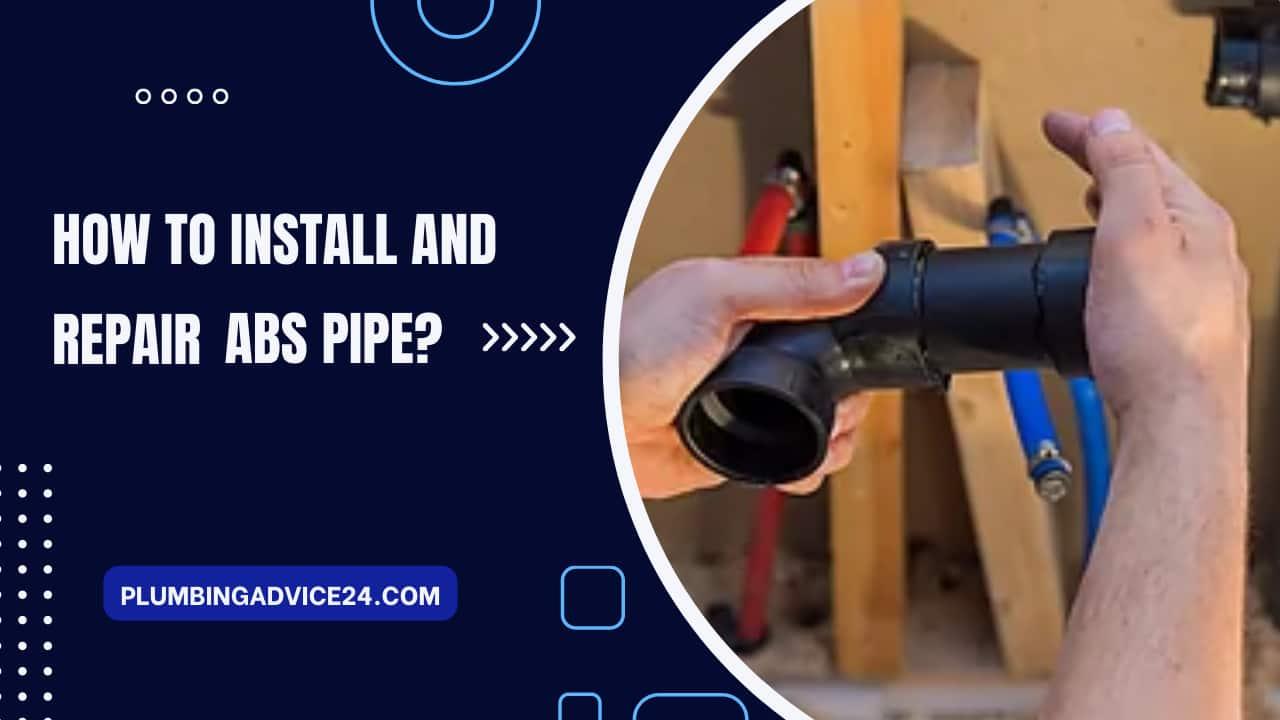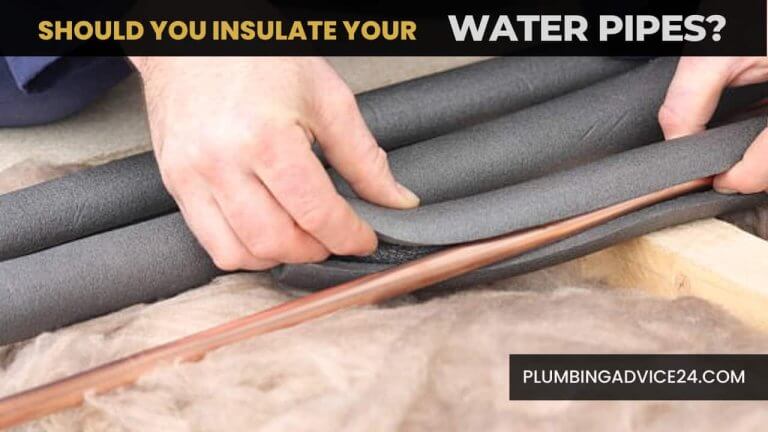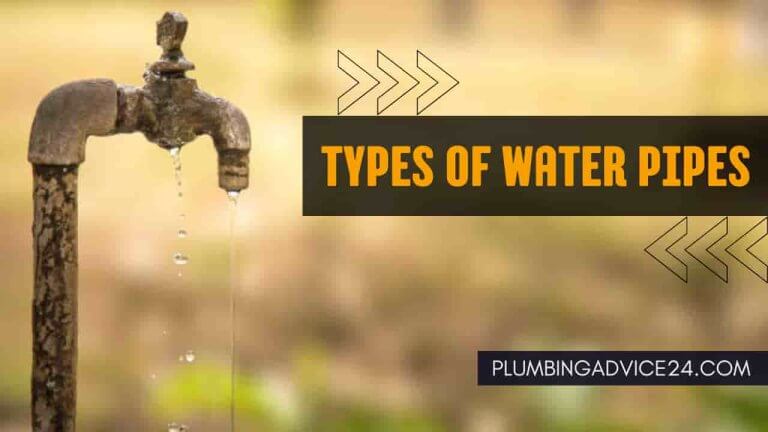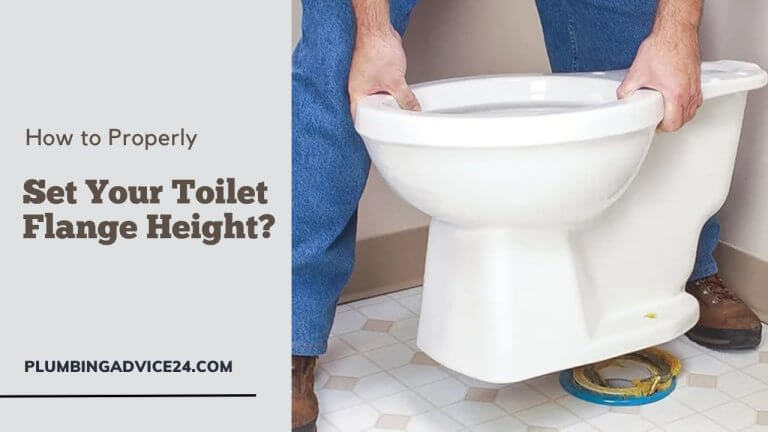How to Install ABS Pipe and Fitting | How to Repair ABS Pipe | ABS Pipe Schedule 40 and Schedule 80
If you plan to install pipes for sewer, drainage, and ventilation systems, ABS pipe is the right choice. Installing and Repairing ABS pipes is a simple and cost-effective method. But you should check your building code before installing ABS pipes, as their use is prohibited in some areas. This article will provide a guide to ABS pipe installation and repair.
How to Install ABS Pipe and Fitting?
ABS pipes are less flexible than PVC pies, making them more difficult to install in certain settings. It has higher impact strength, better durability, and is more cost-effective.
The biggest cause of damage to ABS pipes is improper installation. If joints are not properly connected and fitted, leaks may occur. Second, it should not be installed in a place exposed to sunlight. Exposure to sunlight may cause it to deteriorate.
Here are the steps to install ABS pipes.
- Measure the length of pipe you need by measuring from the inside of the socket of one fitting to the center of the next required fitting.
- Cut the ABS pipe using plumbing tools like a hacksaw, plastic pipe saw, or power miter. Make sure the pipe is cut square so as to maximize access to the fitting.
- Remove all burrs from the inside and outside of the pipe end with a deburring tool and sandpaper.
- Clean the insides of the pipe fittings and the outsides of the pipes with a dry cloth.
- Clean the socket of the fitting with a dry rag. Attempt to glue pipes and fittings in a wet environment only when you have special ABS cement available for use in wet conditions.
- Check the pipe for a proper dry fit in the fitting socket. The pipe fitting should go two-thirds of the way into the socket.
- Apply a light coat of ABS solvent cement conforming to ASTM D2235 to the outside of the pipe and the inside of the fitting socket.
- While the glue is still wet, firmly insert the pipe into the fitting while turning the pipe a quarter turn.
- Hold the pipe in the fitting for a few minutes until the glue sets.
- Wipe off excess glue from the attached area.
- Do not move the system from that location until the joints are set.
What to Consider for Installing ABS Pipes?
The following points should be observed for installing ABS pipes.
- Sometimes, the pipe does not fit into the fitting properly. If the fit is too loose or too tight, the joint will be weak and may break under test pressure. So do not try to use it; return it to the supplier and explain the situation.
- Wear gloves and goggles when using ABS cement.
- Do not use near a naked flame.
- A dirty brush should not be used.
- Do not attach in rain or wet conditions.
- Apply a light layer of glue to the socket. Avoid puddles of cement in sockets.
- Do not use the same brush for different types of cement.
- The code-specified test pressure is usually 5 psi. Do not exceed the specified test pressure when testing the ABS system.
Must Read : 5 Ways to Repair PVC Pipe | PVC Pipe Repair Without Cutting | Replace PVC Pipe Section
Which Connector Is Used to Join ABS to Other Piping?
ABS pipes can be combined with plastic or other pipes. Transit cement is generally used to connect ABS to plastic pipes, while other pipes cannot be joined by cement or glue. Below are options for connecting ABS pipes to plastic or other pipes.
Transition Cement
Transition Cement is Used for joining ABS to PVC pipes. ABS piping does not require a primer, but you should prime the inside and outside of any PVC connection. You should check local building codes before joining the two pipes this way, as many areas prohibit joining PVC and ABS pipes.
Slip Joint Adapter
Slip Joint Adapters are only allowed in accessible areas and will usually create a water-tight seal by hand tightening only. The fixture is used to connect to the tail portion of the outlet pipes.
A slip joint consists of a gasket that fits tightly over the end of the pipe, with a threaded nut behind the gasket, but the position of the gasket is adjustable as needed. The end of this pipe fits loosely with a flange to seal the gasket and threads to a nut to clamp the gasket to the flange.
Fernco Flexible Donuts
Fernco Donuts are designed for compression sealing of ABS sewer pipe and cast iron soil pipe joints such as sockets, hubs, bells, and fixtures.
Donut-shaped rings are made of tough elastomeric polyvinyl chloride; they are strong, resilient, and designed for use as a drain connection material. This flexible donut is designed to provide several points of seal to accommodate possible irregularities in the pipe surfaces.
Mechanical Fittings
Mechanical Fittings are used to join ABS pipe to copper, galvanized, cast iron, clay, and most other pipe materials. This fitting includes bolting, riveting, caulking, compression fitting, and folding, all of which join workpieces using mechanical energy.
Standard fittings are cement-mortar lined and coated with asphaltic material, inside and out. Mechanical joint fittings with special coatings and/or linings may be used for special situations.
Must Read : What Is Pipe Fittings | 12 Types of Pipe Fittings
ABS Pipe Fitting Applications
ABS pipes are not used in potable water lines as they contain BPA chemicals. Pipes are also prone to warping when exposed to sunlight but are mainly used in sewer, drainage, and ventilation systems because they are strong and durable.
Sewer
Due to the strength and durability of ABS fittings, they are widely used in sewer systems. ABS pipe material is extremely smooth on the inside, allowing solids and other liquids to pass through easily.
Drainage
ABS drain fittings can be used to drain water from washing machines or dishwashers. Due to its high-temperature resistance properties, it is not damaged by high-temperature water flowing through piping from some appliances. ABS drain pipe fittings can be used in multiple applications, such as garages, warehouses, or utility rooms.
Ventilation System
ABS pipes lead from the sewer system to the outside and, in many cases, to the roof to help vent the sewer gases outside the home. Venting ABS pipe fittings allow pressure to be equalized on both sides of the trap, which traps water. You should use it for the effectiveness of the sewer and drainage system.
Must Read : What Is a Sewer Line | Types of Sewer Pipes | Best Sewer Line Insurance Company
How to Repair ABS Pipe?
One of the first signs of a problem with ABS pipes is leakage, then roots and moisture in an area for no apparent reason. Water and sewer leakages are a waste of your money and can cause extensive damage to your property.
If you suspect that your ABS drain pipe is leaking, it should be repaired immediately. Here we have given some ABS drain pipe leak repair solutions by which you can repair your leaking ABS pipe at home.
ABS Pipe Joint Leak Repair
- Shut off the water supply to the fixture flowing into the ABS pipe.
- If the fitting is wet, clean and dry the area using toilet paper to soak up all water. Use a wire brush or sandpaper to clean the area.
- Apply feed or resin continuously around the pipe, filling the area between the fitting and the pipe. Feed or resin as an ABS pipe repair kit can be found at your nearest hardware store, which can be applied directly from the bottle between the fitting and the pipe.
- Allow the resin to air-cure for 24 hours. After your first application has cured, you can add any resin to fill the void or strengthen and repair it.
Repair Hole in ABS Pipe
- Make sure the area is clean and dry to the leaky hole. Use a wire brush or sandpaper to clean the area.
- Apply the resin directly from the bottle. Place the resin in the hole and fill it to about the size of a dime. Allow the resin to air-cure for 24 hours.
Replace a Section of ABS Pipe
- Shut off the water supply to the ABS pipe with the shutoff valve.
- Use a clean rag to clean the surface of the pipe. This helps create a clean, dry surface for solvent bonding.
- Cut the damaged pipe with a pipe cutter or hacksaw and discard the damaged section. Remove burrs with a utility knife.
- Apply a layer of glue to the inside of the ABS coupling and the outside of the ABS pipe. Slide the coupling over the ABS pipe with a gentle twist to spread the glue evenly around the pipe.
- Repeat step 4 for coupling at the other end of the ABS pipe.
- Measure the distance between the center seams of the couplings. Cut a piece of ABS to fit. Remove burrs.
- Coat the end of the ABS pipe with ABS glue and slide the pipe into the coupling with an even twisting motion. Use a dry rag to remove excess glue from the joint.
Must Read : How to Install CPVC Pipe | CPVC Leak Repair | CPVC Joint Leak Repair | Causes of CPVC Pipe Failure
ABS Pipe Schedule 40 and Schedule 80 Size Chart
The main differences between schedule 40 and schedule 80 ABS pipes are wall thickness, inside diameter, and weight. Schedule 80 will have a greater wall thickness, smaller inside diameter, and weigh more than Schedule 40 pipe at a given nominal pipe size.
Of course, all these numbers will vary depending on the nominal pipe size. The use of a pipe schedule table is important to ensure that the correct pipe size is selected. Here we have given the ABS pipe size chart for Schedule 40 and Schedule 80:
ABS Pipe Schedule 40 Size Chart
Here, the table is the schedule 40 ABS pipe dimensions chart.
| Schedule 40 ABS Pipe Dimensions | ||||||
| Nom. Pipe Size (in) | O.D | Average I.D | Min. Wall | Nominal Wt./Ft. | Maximum W.P. PSI* |
|
| 1/8 | 0.405 | 0.249 | 0.068 | 0.051 | 810 | |
| 1/4 | 0.540 | 0.344 | 0.088 | 0.086 | 780 | |
| 3/8 | 0.675 | 0.473 | 0.091 | 0.115 | 620 | |
| 1/2 | 0.840 | 0.602 | 0.109 | 0.170 | 600 | |
| 3/4 | 1.050 | 0.804 | 0.113 | 0.226 | 480 | |
| 1 | 1.315 | 1.029 | 0.133 | 0.333 | 450 | |
| 1-1/4 | 1.660 | 1.360 | 0.140 | 0.450 | 370 | |
| 1-1/2 | 1.900 | 1.590 | 0.145 | 0.537 | 330 | |
| 2 | 2.375 | 2.047 | 0.154 | 0.720 | 280 | |
| 2-1/2 | 2.875 | 2.445 | 0.203 | 1.136 | 300 | |
| 3 | 3.500 | 3.042 | 0.216 | 1.488 | 260 | |
| 3-1/2 | 4.000 | 3.521 | 0.226 | 1.789 | 240 | |
| 4 | 4.500 | 3.998 | 0.237 | 2.118 | 220 | |
| 5 | 5.563 | 5.016 | 0.258 | 2.874 | 190 | |
| 6 | 6.625 | 6.031 | 0.280 | 3.733 | 180 | |
| 8 | 8.625 | 7.942 | 0.322 | 5.619 | 160 | |
| 10 | 10.750 | 9.976 | 0.365 | 7.966 | 140 | |
| 12 | 12.750 | 11.889 | 0.406 | 10.534 | 130 | |
| 14 | 14.000 | 13.073 | 0.437 | 12.462 | 130 | |
| 16 | 16.000 | 14.940 | 0.500 | 16.286 | 130 | |
| 18 | 18.000 | 16.809 | 0.562 | 20.587 | 130 | |
| 20 | 20.000 | 18.743 | 0.593 | 24.183 | 120 | |
| 24 | 24.000 | 22.544 | 0.687 | 33.652 | 120 | |
ABS Pipe Schedule 80 Size Chart
Here, the table is the schedule 80 ABS pipe dimensions chart.
| Schedule 80 ABS Pipe Dimensions | |||||
| Nominal Pipe Size (in) | O.D | Average l.D. | Min.Wall | Nominal Wt. ft. | Maximum W.P PSI* |
| 1/8 | 0.405 | 0.195 | 0.095 | 0.068 | 1230 |
| 1/4 | 0.540 | 0.282 | 0.119 | 0.115 | 1130 |
| 3/8 | 0.675 | 0.403 | 0.126 | 0. 158 | 920 |
| 1/2 | 0.840 | 0.526 | 0.147 | 0.232 | 850 |
| 3/4 | 1.050 | 0.722 | 0.154 | 0.314 | 690 |
| 1 | 1.315 | 0.936 | 0.179 | 0.461 | 630 |
| 1-1/4 | 1.660 | 1.255 | 0.191 | 0.638 | 520 |
| 1-1/2 | 1.900 | 1.476 | 0.200 | 0.773 | 470 |
| 2 | 2.375 | 1.913 | 0.218 | 1.070 | 400 |
| 2-1/2 | 2.875 | 2.29 | 0.276 | 1.632 | 420 |
| 3 | 3.500 | 2.864 | 0.300 | 2.186 | 370 |
| 4 | 4.500 | 3.786 | 0.337 | 3.196 | 320 |
| 6 | 6.625 | 5.709 | 0.432 | 6.102 | 280 |
| 8 | 8.625 | 7.565 | 0.500 | 9.269 | 250 |
| 10 | 10.750 | 9.493 | 0.593 | 13.744 | 230 |
| 12 | 12.750 | 11.294 | 0.687 | 18.909 | 230 |
| 14 | 14.000 | 12.41 | 0.750 | 22.681 | 220 |
| 16 | 16.000 | 14.213 | 0.843 | 29.162 | 220 |
| 18 | 18.000 | 16.014 | 0.937 | 36.487 | 220 |
| 20 | 20.000 | 17.814 | 1.031 | 44.648 | 220 |
| 24 | 24.000 | 21.418 | 1.218 | 63.341 | 210 |
Must Read : What Are Copper Pipe | Types of Copper Pipes | Copper Pipe Cost | Copper Pipe Dimension Chart
How to Repair ABS Pipe Without Cutting?
- Make sure the area is clean and dry to the leaky hole. Use a wire brush or sandpaper to clean the area.
- Apply the resin directly from the bottle. Place the resin in the hole and fill it to about the size of a dime. Allow the resin to air-cure for 24 hours.
How to Cut ABS Pipe?
Use an ABS pipe cutter to cut the ABS Pipe. Open the cutter jaws and position the cutting wheel around the pipe, aligning it with the marked line. Apply steady pressure to the pipe while rotating the cutter around it. Gradually increase the pressure while rotating the cutter to create a groove in the pipe. Continue moving the cutter around the pipe until you have completely cut the pipe.
How to Install ABS Repair Coupling?
First, turn off the water supply, and cut the damaged or broken section of ABS pipe using a pipe cutter or hacksaw. Then smooth the ends of the pipe with sandpaper. Take the repair coupling and dry-fit it to the two pipe ends to ensure a proper fit.
Apply ABS cement to the outside of the pipe end and to the inside of the repair coupling. Slide the repair coupling into one pipe end and then the other and hold the pipes in place for a while. Generally, it takes a few hours for the cement to set, once the cement is completely set turn on the water supply and check for leaks.
Do You Need Primer for ABS Pipe?
ABS piping doesn’t require a primer, but you should prime both the male and female sides of any PVC connections. Ensure a neater job by holding the pipe or fitting so that excess primer drips off instead of running down the side.
What Glue Do You Use for ABS Pipe?
While ABS can be bonded with a variety of plastic adhesives (plastic glues), the most common include cyanoacrylate, 2-component epoxy, structural acrylic, and UV-curable adhesives.
Will Silicone Stick to ABS Plastic?
For small plumbing leaks, Loctite Clear Silicone Waterproof Sealant should be used. This silicone sealant is suitable for bonding ABS plastic, rubber, and more. As an added bonus, it is flexible, gap-filling, temperature-resistant, and acts as a sealant and adhesive.
How to Fix Leaking ABS Pipe Joint?
The method to fix the leaking ABS pipe joint is given below.
- Shut off the water supply to the fixture flowing into the ABS pipe.
- If the fitting is wet, clean and dry the area using toilet paper to soak up all water. Use a wire brush or sandpaper to clean the area.
- Apply feed or resin continuously around the pipe, filling the area between the fitting and the pipe. Feed or resin as an ABS pipe repair kit can be found at your nearest hardware store, which can be applied directly from the bottle between the fitting and the pipe.
- Allow the resin to air-cure for 24 hours. After your first application has cured, you can add any resin to fill the void or strengthen and repair it.
If You Liked This Post? So Share It with Your Friends
Suggested Articles:
- What Is Plumbing Pipe | 22 Different Types of Plumbing pipes
- What Is Plumbing Pipe Materials | Which 20 Materials Used to Make Plumbing Pipes
- What Is a Sewer Line | How Many Types of Sewer Pipes | Best Sewer Line Insurance Company
- What is Plumbing Tools | 31 Types of Plumbing Hand Tools
- What Is Plumbing Trap | 15 Different Types of Plumbing Traps And Their Design















